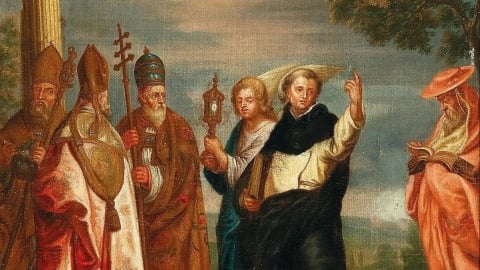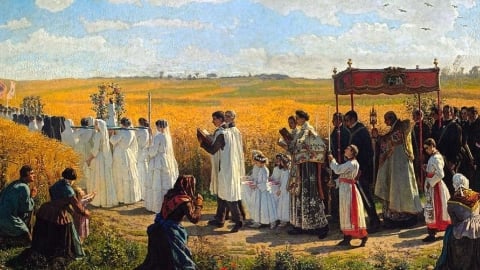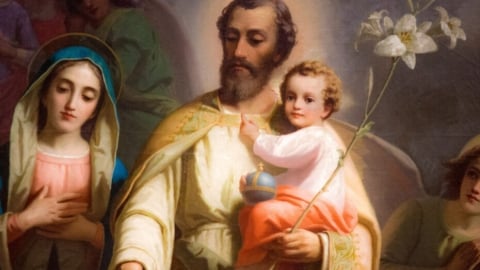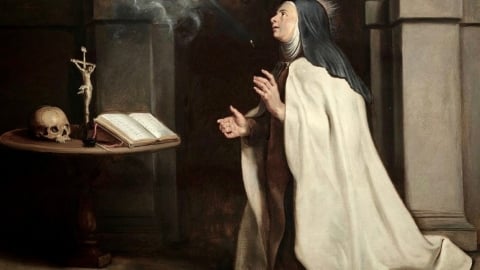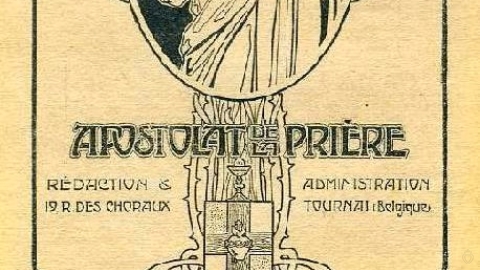Saint John Eudes

In the middle of the 17th century, this zealous priest was called upon by God to establish and promote the liturgical worship of the Sacred Hearts of Jesus and Mary, to train clerics in Major Seminaries, and to renew the Christian spirit among the people through the preaching of missions. He founded six seminaries, preached over one hundred missions in fourteen dioceses of France, and left numerous ascetical and mystical works. He lives on in two Institutes, that of the Eudists and that of the Sisters of Our Lady of Charity, of which he is the Father and legislator. His life is well known thanks to the Mémorial he wrote himself.
Birth - Education - Ecclesiastical vocation
Jean Eudes was born on November 14, 1601, in one of the modest hamlets of the small village of Ri, a dozen kilometers from Argentan in the diocese of Séez. His father, Isaac Eudes, was the only survivor of the plague and had to give up the priesthood: a farmer and country doctor, he recited his breviary every day like the parish priest and was uncommonly pious, as was his wife, Marthe Corbin. Jean was their first-born, after three years of marriage, and the eldest of seven children, one of whom, François Eudes, seigneur de Mézeray (1610-1683), was to become a well-known historian. Jean's birth was heaven's answer to his parents' vow to go on pilgrimage to the chapel of Notre-Dame de Recouvrance, some six leagues from Ri, in the parish of Les Tourailles. From the very first days of his life, this "fruit of prayer rather than nature" was offered in gratitude to Mary at her shrine. The child received from God the most beautiful gifts: a lively mind, an affectionate heart, an upright and energetic will, above all the fear of God and a taste for piety. He made his First Holy Communion on Pentecost Day, 1613, renewing it every month thereafter. In his fourteenth year, he took a vow of perpetual virginity. Blessed in his virtue, he was also blessed in his intelligence, which opened wide to the lessons of his teachers, the Jesuit Fathers of Caen, and he achieved the most brilliant successes in humanities, rhetoric and philosophy at the Collège Royal du Mont, during the five or six years he remained there.
In the dangers of the city, God protected the purity of his faith and morals, and fostered his piety. Around 1618, Jean was received into the Congregation of Notre-Dame, where Jesus bestowed great graces on him through his Mother. A devout congregant of the Blessed Virgin, he was the model of his fellow students, who in their admiration called him the "devout Eudes". He then took her, not only as his Queen and Mother, but as his Spouse; and, confident that the Blessed Virgin approved of his choice, he placed a ring on the finger of one of her statues: some time later, he wrote the contract of this holy alliance, which he signed in his own blood.
Having received advice from his principal, which for him was an order, to enter the ecclesiastical state, he declared his resolution to his parents as soon as he returned to Ri. But his parents, forgetting the promise they had made to Notre-Dame de Recouvrance, were dreaming of a highly advantageous marriage for their son: they had to give in to his energetic resistance. In September 1620, Jean received the tonsure and minor orders at Séez. He returned to Caen to study theology and other ecclesiastical sciences. There, seeing the difficulty of sanctifying himself in the midst of the world, the young cleric, after consulting his confessor and heroically overcoming the opposition of his family, sought and obtained admission to the Society of the Oratory of Jesus (1623), founded in 1611 by a saintly priest, Pierre de Bérulle.
Stay at the Oratory
On March 25, 1624, Jean Eudes entered the house in rue Saint-Honoré, Paris, where the institution or novitiate was established. There, under the direction of Fr. de Bérulle, he trained in the life of prayer and union with Jesus Christ, which characterized the new Congregation, and through it, in all the priestly and religious virtues. After a most fervent year, during which young and old looked up to him as their model, he went to the residence of Aubervilliers, situated almost at the gates of Paris, and prepared himself there, under the eyes of Notre-Dame des Vertus, for holy orders and the priesthood, initiated by the famous P. Charles de Condren, into the cult of the Incarnate Word. He was ordained a priest on December 20, 1625, and celebrated his first mass on Christmas Eve at the altar of the Blessed Virgin in the rue Saint-Honoré church. The following year, illness forced him to take a period of rest.
In 1627, he had just been definitively admitted to the Oratory and was preparing to preach at the Paris house, when a letter from his father asked him to devote himself to the plague victims in the regions around Argentan. With his superior's permission, he set off, assisted by a good parish priest who agreed to put him up, to visit the infected villages, treating and confessing the sick and giving them communion. Two months, September and October, passed in this ministry of heroic charity. By a kind of miracle, the two priests escaped the contagion. The plague having ceased, Father Eudes, on the orders of his superiors, shut himself up in the Oratory house in Caen, to prepare for the missions. This preparation lasted four years, interrupted in 1631 by the devoted care he gave to the plague victims of that city, and by another serious illness which brought him to the doors of the tomb.
In 1632, he and his confreres carried out six missions in the diocese of Coutances, preaching and confessing with such victorious and penetrating unction that his first attempts were considered masterpieces: he reached missionary perfection in one fell swoop. So, after two more years of retreat and study, Fr. de Condren appointed him head of the Oratory's missions in Normandy. The bishops of Bayeux, Saint-Malo and Lisieux successively employed him in their dioceses from 1635 to 1641, and his word, which carried the crowds along, achieved the most consoling results. At Advent 1638, he began a mission in the church of Saint-Etienne in Caen, the fruits of which were greater than can be said. Advent 1639 and Lent 1640, at Saint-Pierre, were even more successful. One day, when Fr. Eudes had deeply moved his audience with a vivid and appalling depiction of divine chastisements, he invited them, in the rush of his zeal, to fall to their knees and cry aloud with him, "Mercy, my God, mercy!" They all immediately dropped to their knees in one motion and repeated these words several times with such compunction that sobbing broke out on all sides. The Rouen mission in 1642 brought him no less triumphs. At his words, the audience often burst into tears; confessionals were besieged for three months; conversions were innumerable: a multitude of bad books and expensive but disgraceful paintings were publicly burned in front of the missionary. Subsequent missions to Saint-Malo and Saint-Lô converted many Huguenots.
Foundation of the Congregation of Jesus and Mary
One of Father Eudes' greatest sorrows was to see that the happy results obtained by him and his collaborators in the missions did not last, for lack of pious and learned pastors to maintain them. Without doubt, the talks he gave to the ecclesiastics and the exercises that accompanied them produced great good but were not enough to cure the evil.
What was needed were Seminaries where clerics could prepare for the reception of holy orders and train in the virtues and functions of their state. So thought St. Vincent de Paul, M. Olier and many others: so thought Father Eudes, and he resolved to found such establishments. For some time, he hoped to realize this resolution in the Oratory. God did not allow it. So, on the advice of holy prelates, learned religious and a large number of enlightened people, and encouraged by the words of a pious girl famous for her mystical states, Marie des Vallées, John Eudes decided to leave the Oratory and set up a new Congregation. Mandated to Paris by Richelieu, received with honor, listened to with attention, approved in his views, he had the joy of receiving, at the beginning of December 1642, the king's letters patent authorizing his future Congregation. Back in Caen, he arranged everything for his establishment.
In a mystical spirit, he chose March 25, 1643 for the birth of his Society, because he wanted to continue the work and functions of the Incarnate Word, and to honor in particular his intimate union with his holy Mother. Wanting that day to mark the beginning, for him and his companions, of the life entirely dedicated to the Son of God that the new Institute was to lead under the auspices of Mary, he left the Oratory on the morning of the 24th. Thirteen kilometers from Caen, towards the sea, stands an ancient sanctuary dedicated to the Blessed Virgin, under the name of Notre-Dame de la Délivrande, a famous and much-frequented place of pilgrimage. He led his collaborators, five in number, there from the first hour of their meeting, to consecrate themselves and their successors to Jesus and Mary. He then moved them into their new home, trusting in Mary's providence and help.
Father Eudes called his work the Congregation of Jesus and Mary, which in his mind was equivalent to the Congregation of the Names and Hearts of Jesus and Mary. This new Institute, purely secular like the Oratory, had as its first and foremost aim the training of pious and zealous priests through seminaries and ecclesiastical retreats. It was placed in a special way under the aegis of the Hearts of Jesus and Mary.
From 1643 to 1670, the founder established six seminaries: in Caen, Coutances, Lisieux, Rouen, Evreux and Rennes; and how many prelates asked him to grant them the same favor! After his death, his sons founded seminaries in Avranches, Valognes, Dol, Senlis and Blois. In founding what came to be known as the "Eudists" and establishing seminaries, the apostle encountered many difficulties, oppositions and contradictions, provoked by jealousy, vice, the Jansenist spirit and hatred; his heroic virtue and prayer triumphed over all. His new works did not prevent him from evangelizing both town and country. While placing seminary exercises above all other duties, he encouraged his confreres to share his apostolic labors. With them, he travelled through Normandy and part of Brittany, the Perche and Chartres regions, Ile-de-France, Brie, Champagne, Burgundy and Picardy, attracting crowds and producing marvelous conversions in over eighty missions between 1643 and 1676. Fr. Eudes had an ardent, daring temperament, a zeal burning with supernatural love, the qualities and gifts that make a true missionary. His contemporaries hailed him as a master of the sacred pulpit, winning over minds and hearts with his strong, holy words, long pondered before God and coming from a heart overflowing with charity. Courageously denouncing vices, rooting out scandalous customs, he never spared the liberating truth, even to the great and the rich. His gentleness and compassion in the confessional resembled that of the divine Shepherd: after striking down crimes, he took pity on the sinner.
The Order of Our Lady of Charity of the Refuge
In the course of his missions, Father Eudes had had the joy of bringing back to God several famous sinners, and, at their request, he had gathered them in the house of a charitable woman, then, in 1641, in a larger and more appropriate location. Furious, the devil breathed discouragement and jealousy into the directors, who, with the exception of one, left the Refuge. The founder asked the Visitandines of Caen to give him a few nuns to govern the repentant girls and train their future directors. In 1644, they granted him three of their sisters, including Mother Patin, a woman of great merit. With her help, he laid the foundations of the Order of Our Lady of Charity, under the rule of Saint Augustine. To the three vows of poverty, chastity and obedience, the nuns of this Order would add the special vow of devoting themselves to the conversion of girls and women fallen or exposed to sinful error. This hospital for souls was a daring creation, hard fought and tested in many ways.
Three other monasteries of the same type were established during the pious founder's lifetime, in Rennes, Hennebont and Guingamp, and four more after his death, in Vannes, La Rochelle, Tours and Paris. Since the French Revolution, the Order has taken on a new dimension. It has spread beyond the borders of France to many countries in Europe and America. The Angers house itself, established as a generalate under the inspiration of God by Marie de Sainte-Euphrasie Pelletier in 1835, forms a thriving branch of the Order, which, under the name of Notre-Dame de Charité du Bon-Pasteur d'Angers, covers all five parts of the world with its establishments.
Devotion to the Sacred Hearts of Jesus and Mary
Fr. Eudes' devotion to the Sacred Hearts of Jesus and Mary dated back to his youth; clear traces of this can be found in one of his works, published in 1637. When he founded his Congregation, he began to organize the worship of the Sacred Heart through daily prayers such as the Ave Cor Sanctissimum, and annual feasts. So it was with the nuns of Our Lady of Charity, who were more especially devoted to the Heart of Mary, while his priests were dedicated to the Heart of Jesus. This cult was not confined to his communities: he spread it to the outside world in his missions, through preaching, prayers, the publication of opuscules and the organization of feasts.
In 1648, with the bishop's approval, he had the first public feast of the Most Sacred Heart of Mary celebrated in Autun, and the feast spread rapidly throughout the dioceses and religious communities, to such an extent that in 1672 Jean Eudes was able to confirm that it was celebrated throughout France. It was even approved in 1668, along with the Office and Mass composed by Fr. Eudes, by Cardinal de Vendôme, legate a latere, whose acts were confirmed by Pope Clement IX; and in 1674 and 1675, Clement X, in six Briefs, recognized and consecrated the existence of confraternities of the Hearts of Jesus and Mary established in seminaries. On July 29, 1672, the Founder ordered all the houses of his Institute to celebrate the Feast of the Sacred Heart of Jesus on October 20, which the house of Rennes had already celebrated with an admirable office of its own composition. This solemnity was extended to monasteries and dioceses where the feast and office of the Heart of Mary had previously been adopted. The Roman Pontiffs have rightly called Father Eudes the author, father, doctor, apostle, promoter and propagator of the liturgical cult of the Hearts of Jesus and Mary; for, before the revelations of Paray-le-Monial, he worked in every way to spread this devotion so opposed by the Jansenists. In parishes where he gave a mission, he usually organized confraternities under the name of the Heart of Jesus and the Heart of Mary. But as these confraternities welcomed all kinds of people, provided they did not lead scandalous lives, he instituted a pious union called the Society of the Heart of the Admirable Mother, for those who, while remaining in the midst of the world, wished to practice evangelical perfection there. Girls and pious widows have always formed the main contingent. Today, this Society is still thriving in Brittany and Normandy, where it is known, by analogy with the ancient Third Orders, as the Third Order of the Sacred Heart, Our Lady of Charity and also the Eudists.
Opposition to Jansenism - Ascetic Writings: Death
While placing himself among the moderates and the wise, among those who, strongly attached to the traditional doctrine of the Church and the pontifical constitutions, knew how to act and speak out when necessary, but usually avoided the clash of opinions and the battle of words so sought-after by others, Father Eudes was a declared enemy of Jansenism, and his opposition brought him the cruelest persecutions. It would be too long a chapter to recount them.
Nor can we dwell on the lively, luminous faith that lifted his spirit above the earth, making him look upon all things in God and Jesus Christ; on the unshakeable hope that served him as a firm and sure anchor in the midst of storms; on the ardent charity that consumed him day and night for God and his brothers, and gave him the courage to undertake and bring to a successful conclusion, for the glory of God and the salvation of souls, works that human weakness would scarcely have dared to conceive.
Speaking and acting were not enough for Fr. Eudes: he also wanted, through his pen, to promote the Christian spirit among the faithful, the priestly spirit among priests: hence numerous and remarkable works, in the words of Leo XIII. “Baptism: Man’s Contract with God” is not the least of his small volumes. “The Life and Kingdom of Jesus in Christian Souls,” “Meditations on Humility,” “Conversations Between the Christian Soul and God,” “Memorial of the Ecclesiastical Life,” “The Apostolic Preacher,” “The Good Confessor,” and “The Admirable Heart of Mary” - (a work completed shortly before his death); these are the main ones to have been printed.
The closer John Eudes came to the grave, the heavier and more bruising became the trials and crosses that were inseparable companions in his life. Sickness and bereavement of devoted friends, slander and calumny peddled by Jansenists or even by people consecrated to God, dishonest maneuvers to separate him from Rome and deliver him to the king, a libel launched in public, the painful infirmities of his last years - nothing was spared him. In 1680, he resigned as Superior General. After addressing his last wishes and recommendations to his family and friends, he received Viaticum on his knees on the floor of his room and died in a spirit of ardent charity at the age of seventy-nine, on August 19.
His body was buried in the church of the Caen Seminary. In 1810, his remains were taken to the church of Notre-Dame de la Gloriette, chapel of the former Collège du Mont; part of his body was entrusted to the monastery of Notre-Dame de la Charité in Caen.
Canonical proceedings, begun in 1868, led to beatification (April 25, 1909) under Pius X, and then to canonization by Pius XI on May 31, 1925. His feast day, extended to the universal Church in May 1928, is set for August 19. On February 18, 1932, the marble statue of St. John Eudes, founder of the Eudists and the Sisters of Our Lady of Charity, was placed in St. Peter's in Rome.
Source: https://laportelatine.org/spiritualite/vies-de-saints/saint-jean-eudes
